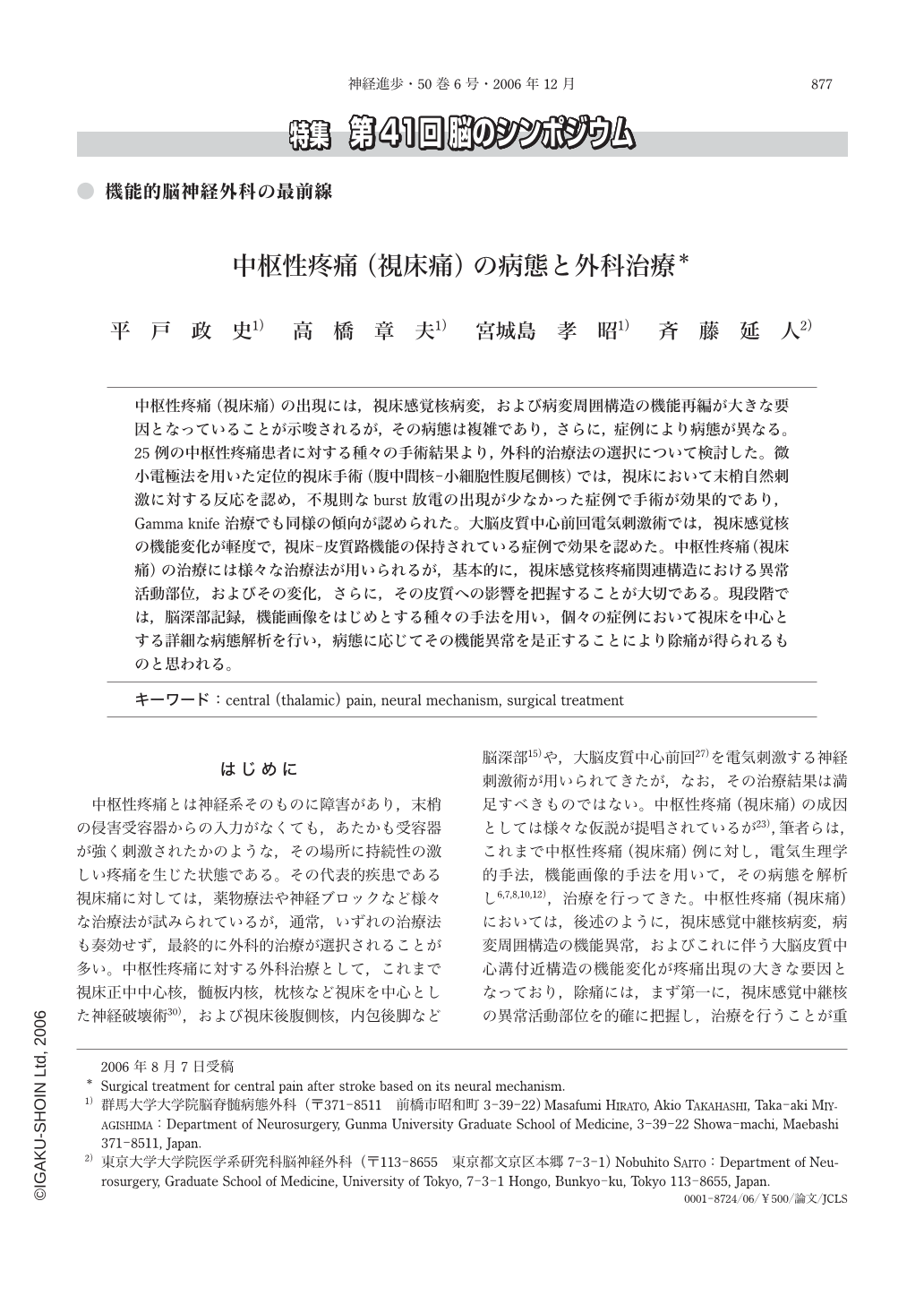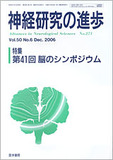Japanese
English
- 有料閲覧
- Abstract 文献概要
- 1ページ目 Look Inside
- 参考文献 Reference
中枢性疼痛(視床痛)の出現には,視床感覚核病変,および病変周囲構造の機能再編が大きな要因となっていることが示唆されるが,その病態は複雑であり,さらに,症例により病態が異なる。25例の中枢性疼痛患者に対する種々の手術結果より,外科的治療法の選択について検討した。微小電極法を用いた定位的視床手術(腹中間核-小細胞性腹尾側核)では,視床において末梢自然刺激に対する反応を認め,不規則なburst放電の出現が少なかった症例で手術が効果的であり,Gamma knife治療でも同様の傾向が認められた。大脳皮質中心前回電気刺激術では,視床感覚核の機能変化が軽度で,視床-皮質路機能の保持されている症例で効果を認めた。中枢性疼痛(視床痛)の治療には様々な治療法が用いられるが,基本的に,視床感覚核疼痛関連構造における異常活動部位,およびその変化,さらに,その皮質への影響を把握することが大切である。現段階では,脳深部記録,機能画像をはじめとする種々の手法を用い,個々の症例において視床を中心とする詳細な病態解析を行い,病態に応じてその機能異常を是正することにより除痛が得られるものと思われる。
Neurophysiological and neuroimaging study suggested that functional changes might occur in the sensory thalamus, associated with reorganization of thalamocortical system, in cases with central(thalamic)pain. It might cause hyperactive response to peripheral natural stimulation, resulting in playing important roles for the genesis of this type of pain. Hyperactivity in the cerebral cortex adjacent to the central sulcus on the side ipsilateral to CVD lesion also might relate for the genesis of central pain.
Based on these hypothesis of the neural mechanism of central pain after stroke, we performed various kinds of surgical treatment in 25 cases with central pain. Pain was caused by cerebrovascular disease(CVD)in all cases. Epidural spinal cord stimulation was effective in 4 cases with localized pain on the distal part of leg and arm. Stereotactic(Vim-Vcpc)thalamotomy was performed in 13 cases with diffuse pain with aid of depth microrecording. Long-term pain relief over three years was achieved in 6 cases. PET study was also carried out to clarify the characteristic changes in the brain. In cases obtained pain relief, we could find responses to peripheral natural stimulation and seldom encountered irregular burst discharges on the sensory thalamus during the operation. Preoperative PET study also revealed an increase of rCBF on the sensory cortex ipsilateral to the thalamic CVD lesion during contralateral thumb brushing. On the other hand, in cases without pain relief, we frequently encountered irregular burst discharges and positive spikes, but seldom found sensory responses to peripheral natural stimulation on the sensory thalamus. Gamma knife treatment was carried out in 11 cases, in 6 out of those which stereotactic thalamotomy had been performed. Each case was treated with a maximum dose of 120-150Gy using 4mm collimator. In 7 cases before introduction of neurostimulation therapy, pain improved in 5 cases, and became stable in these 3 out of 5 cases. In 2 cases, pain was not ameliorated. In the other 4 out of 11 cases, pain improved in 2 cases and was not ameliorated in 2 cases. MRI revealed the formation of therapeutic thalamic lesions in those cases, which were recognized as a spot-shaped low signal area on T1-and T2-weighted images, which was surrounded by high signal area on T2-weighted image. It also revealed a spot-shaped enhanced high signal area on the T1-Gd enhanced image. Precentral electrical cortical stimulation was also performed in 6 cases. Sufficient pain relief was achieved in 3 cases. In all these cases, spontaneous pain was severe but hypesthesia mild. Regional CBF or rCMRglu decreased slightly and was localized in the affected thalamus. A MEG study demonstrated preservation of spino-thalamo-cortical function in one case. In 2 out of 3 cases in which we failed to obtain pain relief, we frequently encountered irregular burst discharges and positive spikes, but seldom found sensory responses to peripheral natural stimulation on the sensory thalamus during the previous thalamic operation. In one of these 3 cases, internal capsular(posterior limb)stimulation was performed, resulting in sufficient but short-term pain relief.
Surgical treatment could be expected to ameliorate central(thalamic)pain in those cases in which CVD had caused mild destruction of the pain conducting system and the spino-thalamo-cortical function was relatively preserved. Based on the electrophysiological and neuroimaging data mainly in the thalamus, we should make a further surgical treament strategy to improve functional abnormalities on the thalamocortical system for this intractable pain.

Copyright © 2006, Igaku-Shoin Ltd. All rights reserved.


